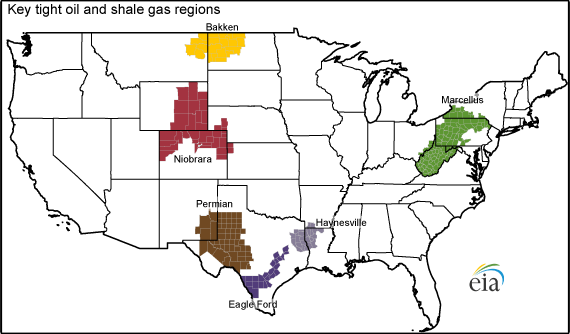The black-gold rush in North Dakota—a technological revolution in oil production—is creating a new class of rugged millionaires. North Dakota might be grabbing headlines, but horizontal drilling and “fracking” to tap into newly accessible oil reserves is by no means limited to that state.
The shale revolution is still in its “early innings,” as a recent report by Credit Suisse put it. OPEC’s 2013 World Oil Outlook, published last month, said that new oil supply from the U.S. and Canada would hit nearly 5 million barrels a day within five years, up from last year’s forecast of 1.7 million barrels a day by 2018. As that boom plays out, tens of billions of dollars in new infrastructure and development will likely be invested in the coming years.
Where will the new investment be concentrated? Though oil and gas companies across the U.S. are busy buying up acres of mineral rights in oil shale hot spots in an effort to be early players in the next booms, most are staying quiet about early production numbers. If they let on that they’ve uncovered another Bakken or Eagle Ford Shale, land and production costs could skyrocket. In Texas’s Eagle Ford, for example, companies were paying $250 to $450 an acre in 2009 when the area’s potential was unknown, but by 2011, an acre was going for $21,000 to $22,000.
Related: 10 Highest-Paying Jobs in North Dakota’s Oil Boom
The U.S. Geological Survey (USGS) and the Energy Information Administration (EIA) have only recently started to assess reserve areas, and the EIA estimates 482 trillion cubic feet of natural gas and 33 billion barrels are recoverable, revised from a mere 4 billion barrels in 2007.
That estimate could still be conservative, however. The amount of recoverable oil in an area only becomes evident after companies begin to drill. “Early on, we didn’t have much experience on how these wells would be producing,” says Doug Duncan, associate coordinator of the energy resources program at the USGS. “We typically need about three years of production data from a large number of wells before we can start to reduce the uncertainty in our assessments.”

In North Dakota, the USGS estimated there were 3 to 4.3 billion barrels in 2008, but this year, it revised its number to 7.4 billion barrels. The USGS is now working on an assessment of the Monterey Shale in Southern California.
Despite the uncertainty, some areas are starting to garner attention. While these emerging areas could see new infrastructure, job creation, and increased worker-migration, each state has different regulations for drilling and fracking – a factor that could slow down or potentially halt production. In addition, any fluctuations in price or demand of crude oil could impact development. Here are five areas to watch:
TEXAS
Though Texas has already been booming, it’s expected to nearly double its production in the coming year and is on pace to surpass Kuwait and the United Arab Emirates by 2015.
Beyond Eagle Ford in West Texas, which has been developing rapidly for a few years (the area went from issuing only 94 new drilling permits in 2009 to 5,230 last year, a 500 percent increase), other shale formations being explored are the Bone Spring and Wolfcamp plays in the Permian Basin. A report this summer by Wood Mackenzie, an energy research firm, estimated that capital investments in the area could jump 57 percent to $22 billion in the next five years, when the region could be producing 1 million barrels of oil per day.
In the northeastern Texas Panhandle lie the Granite Wash and Hogshooter reservoirs, both sections of the Anadarko Basin. Each well in the approximately 2.5 million acre region has the estimated potential to recover 1.1 million barrels of oil. A major producer in the area, Chesapeake Energy Corp., drilled its most successful well in the Hogshooter formation in Wheeler County last year, producing 5,400 barrels of crude during its first eight days and out-performing those in the Bakken and Eagle Ford.
CALIFORNIA
Four times larger than North Dakota’s Bakken, the Monterey Shale in southern California has oil companies from all over the world clamoring for the crude trapped some 15,000 feet below the surface. The Monterey Shale “may be the only formation that can match the resource potential of Bakken, Eagle Ford and the Permain Basin,” writes Leonardo Maugeri of Harvard’s Kennedy School in a 2013 report titled The Shale Oil Boom: A U.S. Phenomenon.
The Monterey shale could hold over 400 billion barrels of oil, about half the conventional oil in Saudi Arabia, with an estimated 15 billion barrels of those now recoverable, according to the U.S. Department of Energy. Tapping into this could create up to 2.8 million new jobs a year, according to a recent University of Southern California study. “The Monterey shale is in an area where there is already a lot of oil and gas infrastructure, so that makes it a target that could be developed more rapidly,” says Duncan at the USGS.
Related: 11 Shocking Facts About the North Dakota Oil Boom
The problem, according to geologists, is that the San Andreas Fault has caused folds and slopes in the shale layers, and the rock hasn’t responded as well as flatter regions like North Dakota to hydraulic fracturing and horizontal drilling. The Golden State is also known for its powerful environmental lobbying groups, many of which have petitioned for state legislators to ban the practice of fracking altogether.
OKLAHOMA
After North Dakota and Texas, Oklahoma is the third-fastest growing state for oil production, doubling its output since 2010. Though the state has had traditional oil production for years, output has been declining since the early 1990s. But with recent fracking and horizontal drilling technologies, oil output this summer was the highest for the state since January 1990 at 320,000 barrels of oil per day.
Production should be able to keep growing in part because another section of the Anadarko Basin is located in southern Oklahoma: the 3,300 square mile Woodford shale formation, which contains 400 million barrels of recoverable oil, according to the 2010 U.S. Geological Survey.
Continental Resources, Inc. has called the Woodford shale “one of the thickest, best quality resource shale reservoirs in the country.” Continental has been buying up mineral rights in the area and revealed last year that Woodford (also called the South Central Oklahoma Oil Province, or “SCOOP”) is its next big target for development. It’s already drilled 93 wells, and produced 17,550 barrels of oil per day in the second quarter of 2013, up more than 400 percent from the year before. Another company investing in the area is Baker Hughes, which increased its rigs in the area from 6 in 2011 to 32 in October 2013.
Another potential boom area is in northern Oklahoma and into southwestern Kansas, home to the Mississippian Lime formation. Sandridge Energy’s former CEO, Tom Ward, told CNBC last year that the formation could rival production levels in the Bakken by the end of the decade. The region is currently producing about 3.5 million barrels a month, and is expected to create 1 million jobs in the next 15 years.
COLORADO
Colorado has a number of emerging oil shale plays. This year, the state approved over 1,200 new permits to drill horizontal wells in Colorado, surpassing the number in 2012. As of May 2013, the state was producing an average of 156,000 barrels of oil per day, the highest level in more than 50 years.
“There are many areas of shale deposits in Colorado and other western states that have good potential for shale oil and shale gas production,” says John Dyni, a mineral resource specialist at the USGS. He predicts that Denver and Grand Junction will both become centers for the increased activity.
The Niobrara formation is near Denver. Noble Energy Inc. has invested heavily in the area, and plans to spend an additional $10 billion between 2013 and 2017. Anadarko Petroleum Corp has also invested about $3.3 billion in the Niobrara region from 2007 to 2012.
In northwest Colorado, the Green River Formation, which also extends into Utah and Wyoming, is estimated to hold some 3 trillion barrels of oil, enough to satisfy the world’s oil needs for 100 years, though traditional fracking methods have not been as successful in Green River’s tighter rock formations and costs of extraction are high.
LOUISIANA
Spanning 2.7 million acres across central Louisiana is the Tuscaloosa Marine shale, estimated to hold 7 billion barrels of recoverable oil. The formation is getting attention from oil companies – Goodrich Petroleum Corp. recently purchased 185,000 acres in the region – and could respond well to fracking techniques. “The play is extremely over-pressured, which results in high oil saturations and helps to naturally lift the oil up the wellbore,” wrote Keith Schaefer of Oil and Gas Investments Bulletin recently.
Another emerging area in northern Louisiana and into Arkansas is the Smackover Brown Dense shale, which could have some 3 billion barrels of recoverable oil. Southwestern Energy Production Co. has invested heavily in the area, buying up more than a half a million acres. According to the company’s third-quarter earnings report, it recently completed its “best well to date” there, which produced 600 barrels of oil per day at its peak.
Blaire Briody is a freelance writer currently working on a book about North Dakota’s oil boom. You can follow the project on Facebook or through the blog.
Top Reads from The Fiscal Times:





